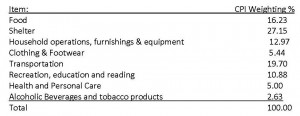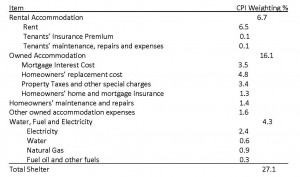The Problem With A CPI Based Maximum Rent Increase
The problem with basing a rental rate increase on the Consumer Price Index (CPI) is that the rental market is not based on CPI. LandlordBC has prepared a CPI analysis to illustrate that those items of the All Item CPI Index (AIC) which are directly applicable to the operation of a rental apartment building represent only 10.0% of the CPI. Therefore, the majority of CPI (90%) is not applicable to the operation of a rental apartment building and therefore the AIC does not form a legitimate base to establish maximum rental rate increases. Whereas the AIC is being used to establish increases in market rents for a residential rental property, only 10% of the AIC is actually applicable to the cost of operating a residential rental property. The correlation between maximum rental rate increases tied to CPI and the changes in operating expenses is very weak as the following analysis demonstrates. Our sector deserves an index that is more representative of our actual costs drivers. LandlordBC will continue to advocate for change so that we may have a strong and vibrant rental housing ecosystem.
Components of the All Item CPI Index (September 2017)
The All Item CPI is based on the following components and weightings:

It is noted that many of the components of the CPI are not related to the operation of a rental apartment building. Although substantial changes in some components of the CPI may have a substantial impact on a renter, these changes may have no impact on the operation of the rental building. Conversely, substantial changes in some components of the CPI may have a substantial impact on the operation of a rental apartment building but have no direct impact on the rent that a renter will pay.
The section of the AIC that most directly relates to the operation of a rental apartment building is Shelter. The Shelter component of the CPI is based on the following items and weights:
Components of the All Item CPI Index Which Relate to a Rental Apartment Building

The total Shelter component of the CPI reflects 27.1% of the total CPI, however, even within the Shelter component, there are items which are not applicable to the operation of a rental apartment building.
Those items which are applicable to the operation of a rental apartment building are as listed below:

Those items which are directly applicable to the operation of a rental apartment building represent 10.0% of the CPI, therefore, the majority of CPI is not applicable to the operation of a rental apartment building and therefore the All Item CPI does not form a legitimate base to establish maximum rental rate increases.
Relative Weighting between the CPI Index and Rental Apartment Building Expenses
The cost to operate rental apartment buildings vary due to size, location, construction, tenant base, wind and sun exposure, renovations, energy efficiency upgrades, as well as a large number of other factors. LandlordBC conducted a review of analysis of typical expense levels for a variety of rental apartment buildings in the Lower Mainland (predominantly Vancouver) and then compared these expenses with the AIC, as well as with the Shelter Component of the CPI to establish relative weightings.

The above components represent 10.0% of the All Item CPI however, they represent approximately 65.8% of the operating expenses for a typical rental apartment building. The percentage of operating expenses varies widely depending on location within the province, with northern and central communities experiencing substantially higher Electricity and Natural Gas costs.
